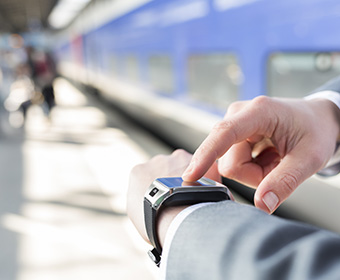
(April 23, 2018) -- A new study by Murtuza Jadliwala, assistant professor of computer science at The University of Texas at San Antonio, examines wearable technology and whether it affects drivers’ concentration. Jadliwala and his collaborators discovered that while a driver texting with a wearable device can marginally reduce their level of distraction, it ultimately makes texting while driving just as dangerous as with an ordinary cell phone.
“Dr. Jadliwala’s research on evaluating the influence of technology on consumer safety and privacy is timely and significant,” said Rajendra Boppana, chair of the UTSA Department of Computer Science. “His work on wearable technologies is a great example of impactful research driven by experiments, an approach highly valued by computer scientists.”
More than a quarter of car accidents reported each year are attributed to some form of distraction among drivers, often the result of talking or texting while driving. Nine people are estimated to die every day in the U.S. from distracted driving and 330,000 injuries occur each year because of texting while driving, which is also the most common cause of death in teenagers.
Jadliwala worked with Jibo He, associate professor of psychology at Wichita State University and Jason S. McCarley, professor of psychology at Oregon State University, to create a safe environment where distracted driving could be measured.
“We recruited about 20 volunteers on a university campus,” Jadliwala said. “They used a driving simulator in a laboratory that included a three-screen display, a wheel and pedals.”
Student volunteers were tasked with “driving” in the simulator, using either a smart phone or Google Glass. Jadliwala and his collaborators sent the participants text messages and challenged them to drive safely while receiving and responding to the messages. The simulator recorded deviations in the steering wheel and whether the volunteers drifted out of their lane.
“We found that the Google Glass distracts the driver slightly less,” he said. “But that also gave the participants a false sense of safety.”
Because the wearable device responded quicker and used voice-activated controls, the drivers noticed the increased efficiency but also were more likely to engage with the device, which negated the marginal safety difference between the smart phone and the wearable device.
While Google stopped producing Google Glass in 2015, wearable technology is becoming increasingly popular. Jadliwala noted that wrist wearables such as Apple Watch has been very successful and that more modern head-mounted displays like Google Glass are in development.
“It’s important to keep asking these questions as technology becomes a bigger part of our everyday lives,” he said. “A wearable device feels more accessible because it’s on your body, which is why it’s important to study how it could impact tasks like driving.”
Jadliwala is also involved in research focused on preventing accidents related to pedestrians distracted by cell phone usage. He joined UTSA in 2018 from Wichita State University and is the director of the UTSA Security, Privacy, Trust and Ethics in Computing Research Laboratory, which conducts fundamental and applied research in the security and privacy of wireless and mobile networking systems.
UTSA is ranked among the top four universities in the nation under 50 years old, according to Times Higher Education.
Learn more about the UTSA Department of Computer Science.
Read Murtuza Jadliwala’s study, “Does a wearable device bring distraction closer to drivers? Comparing smartphones and Google Glass.”
Connect with UTSA online at Facebook, Twitter, YouTube, Instagram and LinkedIn.
UTSA Today is produced by University Communications and Marketing, the official news source of The University of Texas at San Antonio. Send your feedback to news@utsa.edu. Keep up-to-date on UTSA news by visiting UTSA Today. Connect with UTSA online at Facebook, Twitter, Youtube and Instagram.
This event will acknowledge graduating seniors from the McNair Scholars program at UTSA before inducting the new cohort of scholars into the program.
North Paseo Building (NPB 5.140), Main CampusAt this memorable celebration, UTSA graduates will be introduced one-by-one to cross the stage and accept their doctoral degrees.
Arts Building Recital Hall, Main CampusRoadrunner Walk is an event for graduating students to have a memorable walk on campus to celebrate an important milestone and their achievements. Graduates will walk along the Paseo while being celebrated by the UTSA community, friends, and family members.
Student Union Paseo, Main CampusCelebrate the accomplishments of College of Education and Human Development, College for Health, Community and Policy, College of Sciences and University College.
Alamodome, 100 Montana St.Celebrate the accomplishments of Alvarez College of Business, College of Liberal and Fine Arts and Klesse College of Engineering and Integrated Design.
Alamodome, 100 Montana St.The University of Texas at San Antonio is dedicated to the advancement of knowledge through research and discovery, teaching and learning, community engagement and public service. As an institution of access and excellence, UTSA embraces multicultural traditions and serves as a center for intellectual and creative resources as well as a catalyst for socioeconomic development and the commercialization of intellectual property - for Texas, the nation and the world.
To be a premier public research university, providing access to educational excellence and preparing citizen leaders for the global environment.
We encourage an environment of dialogue and discovery, where integrity, excellence, inclusiveness, respect, collaboration and innovation are fostered.
UTSA is a proud Hispanic Serving Institution (HSI) as designated by the U.S. Department of Education .
The University of Texas at San Antonio, a Hispanic Serving Institution situated in a global city that has been a crossroads of peoples and cultures for centuries, values diversity and inclusion in all aspects of university life. As an institution expressly founded to advance the education of Mexican Americans and other underserved communities, our university is committed to promoting access for all. UTSA, a premier public research university, fosters academic excellence through a community of dialogue, discovery and innovation that embraces the uniqueness of each voice.